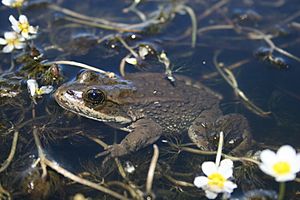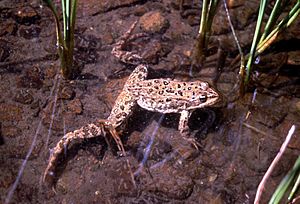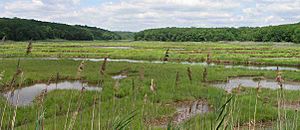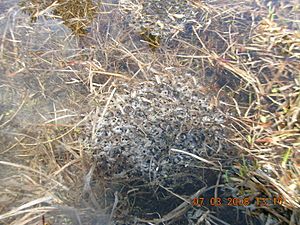Columbia spotted frog facts for kids
Quick facts for kids Columbia spotted frogRana luteiventris |
|
|---|---|
 |
|
| Conservation status | |
| Scientific classification | |
| Synonyms | |
|
Rana pretiosa luteiventris Thompson, 1913 |
The Columbia spotted frog (Rana luteiventris) is a type of frog found in North America. These frogs are usually green or brown. They have spots on their backs. Their bellies and upper lips are white.
You can tell them apart from other Rana frogs. They have shorter back legs and a narrow snout. Their eyes also point upwards. Since they spend most of their time in water, their hind feet have more webbing than other similar frogs. This frog is not currently in danger. However, scientists study it to learn how losing parts of its habitat affects animals.
Contents
What Does the Columbia Spotted Frog Look Like?
The Columbia spotted frog is a medium-sized frog. It can grow up to 3.5 inches (90 mm) long. Its color can be dark olive green or light brown. It has black spots that are not perfectly shaped on its back and legs. This is how it got its name!
Its skin can be rough or smooth. It often has small folds of skin along its back. A cool thing about this frog is its color. It has a light-colored stripe along its upper lip. Adult frogs also have pink or yellow bellies.
This frog has a few special features. It has a long, narrow snout and eyes that point up. It is known for living mostly in water. The webbing on its feet goes all the way to the end of its longest toe. Compared to other frogs of the same size, like the northern leopard frog, it has shorter back legs.
The tadpoles (baby frogs) are brownish-green on their backs. They also have gold spots. Their eyes point upwards and are set into their heads. Tadpoles usually grow to about 3.1 inches (80 mm) before they become adult frogs.
Where Does the Columbia Spotted Frog Live?
Where in the World Do They Live?
The Columbia spotted frog lives across western North America. You can find them in Alaska and parts of British Columbia in Canada. They also live in Washington, Idaho, and parts of Wyoming, Nevada, and Utah in the United States.
What Kind of Home Do They Like?
Like most frogs, the Columbia spotted frog loves water. They usually live near places with water all the time. This includes lakes, ponds, slow-moving streams, and marshes.
These frogs need specific features in their watery homes. Adult frogs often live in places that flood at certain times of the year. This means the water level and amount of water can increase a lot.
What Plants Do They Need?
These frogs are often hunted by other animals. So, they need places with lots of low-growing vegetation (plants). Much of this vegetation is under the water. This includes different types of algae and other water plants.
Spotted frogs usually do not live in areas with lots of tall grasses or sagebrush. These plants are not as good for hiding as water plants. The Columbia spotted frog rarely leaves these watery areas. However, they might travel a bit to find a place to lay their eggs.
How Do Columbia Spotted Frogs Reproduce?
The Columbia spotted frog reproduces like other amphibians, but with some special details. They need to lay eggs in areas where plants grow out of the water. Two of their favorite plants for laying eggs are reed canary grasses and cattails. They lay their eggs in the same places they live: ponds, slow-moving streams, and lakes.
Male frogs sing to attract females for mating. Their song can be a series of clicks or long, deep sounds. An interesting thing about their reproduction is that the male frog arrives at the breeding grounds first. He chooses the spot for laying eggs before the females are ready to mate.
Female Frogs and Their Eggs
Once the male picks the egg-laying spot, the female starts to lay her eggs in shallow water. The male then fertilizes the eggs. The egg masses are quite large. They can have up to 1300 eggs! Once laid, the egg masses soak up water and grow to about the size of a softball.
These eggs are not attached to any plants. They float freely in a permanent water source. Soon after, the eggs hatch into tadpoles.
When Do They Breed?
When Columbia spotted frogs breed depends on where they live and how high up the land is. In British Columbia, they breed in February near sea level. In areas around Utah, they breed around mid-March at about 1,395 m (4,577 ft) (4,577 feet) high. In Wyoming, they breed from May to June at elevations around 2,377 m (7,799 ft) (7,799 feet).
Female frogs breed every year in lower places. In higher places, they might breed every two to three years.
What Do Columbia Spotted Frogs Eat?
This frog is not picky about its food. It will eat many different insects. These include grasshoppers, ants, wasps, beetles, and moths. These insects make up more than half of the frog's diet.
This frog also eats some surprising animals. These include crustaceans (like tiny crabs), mollusks (like snails), arthropods (like spiders and insects), and arachnids (like spiders).
Besides insects, the Columbia spotted frog also eats algae, bits of dead plants, and other small living things that live in the water.
See also
 In Spanish: Rana luteiventris para niños
In Spanish: Rana luteiventris para niños





